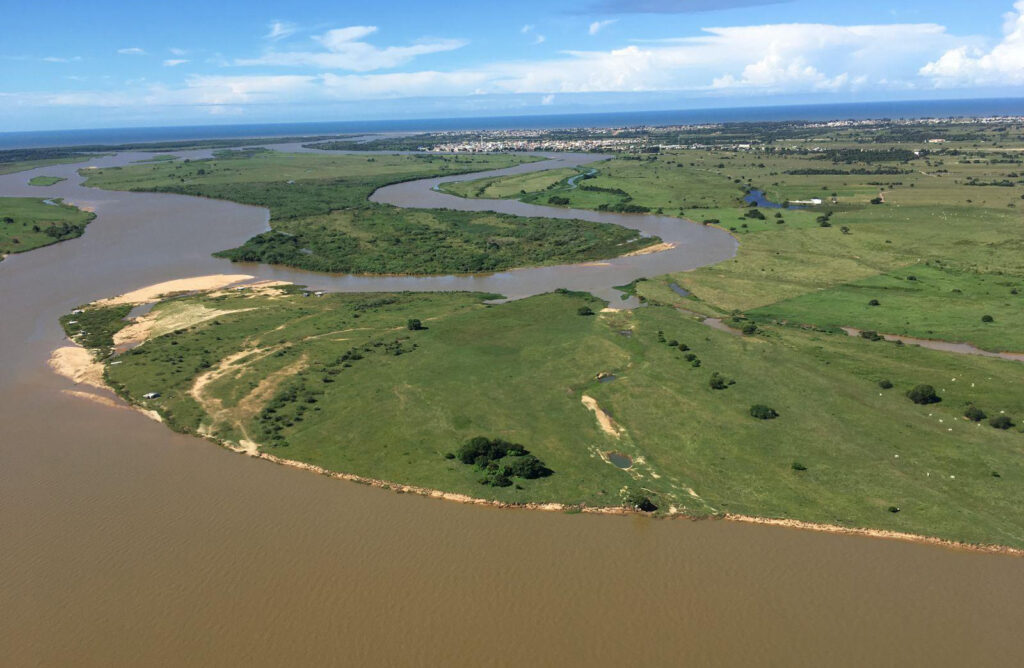Deltas Working Group

Aerial view from Paraiba do Sul river delta (21°38’53.18″S; 41° 5’18.96″W). Paraiba do Sul is a typical wave-dominated cuspate delta, observed along eastern part of Brazil.
WG chairs:
Prof. Guilherme Fernandez (guilhermefernandez@id.uff.br)
Universidade Federal Fluminense (Brazil)
Prof. Subhamita Chaudhuri (subhamita.chaudhuri@gmail.com)
West Bengal State University (India)
WG secretary:
Dr. Sayantan Das (sayantdas@gmail.com)
Dum Dum Motijheel College (India)
Introduction
‘Deltas’ can be defined as accumulations of river-derived sediment deposited on or near the coast, when a stream enters a receiving body of water, which may be an ocean, sea, gulf, lagoon, estuary or lake. The origin of this term takes us to ancient Egypt, where the Nile River, before entering the Mediterranean Sea, produced a triangular island which looked like the fourth letter of the Greek alphabet— Δ (Delta).
Deltas can be understood based on process-depend feature, in this case the deltaic morphodynamic behavior depends on the relationship from fluvial and coastal processes. The morphology observed in different Deltas allows to be classified based on physical processes that accumulate sediments specific patterns. The process-based classification primarily accounts for wave-dominated (e.g. São Francisco and Paraiba do Sul), tidedominated (e.g. Ganga-Brahmaputra-Meghna Delta), and estuarine (Yellow River Delta) deltaic systems. Another type of process-based formation is subaqueous delta, which does not have a subaerial expression due to the confrontation of a major river with an extremely energetic oceanic regime (e.g. Amazon River mouth). The shape-based classification comprises of arcuate delta (e.g. Nile Delta, Rhine Delta), bird-foot delta (e.g. Mississippi Delta), cuspate delta (e.g. Tiber Delta), and inverted delta (e.g. Sacramento-San Joaquin Delta, Tagus Delta). The other types of deltas may include inland delta (e.g. Okavango Delta), and abandoned delta (examples can be found within Ganga-Brahmaputra-Meghna Delta and Mississippi Delta).
All the active deltas in the world, in their present form, developed during the Quaternary. Densely populated in most of the cases, the deltaic landscape is extremely important not only from the perspectives in geomorphology, but includes agriculture, trade, and commerce.
Thrust areas
- Morphodynamics of coastal deltas, tidal basins, and lacustrine deltas; Impacts of sea
level rise; - Quaternary deltaic evolution based on geochronology and shallow geophysics;
- Deltaic-estuarine circulation — wave, riverine, tidal processes, and sedimentation
- Functioning and services of wetland ecosystems — estuarine waters/ mudflats, special focus on mangrove ecosystem;
- Deltaic settlements: flood protection, subsidence, climate proofing;
- Reclamation of deltas: Social-cultural/ ecological/ hydro-geomorphic impacts; economic perspective, feedback mechanisms;
- Response of deltaic/ estuarine systems to sea level rise, estuarine pollution, dredging, land subsidence, cyclones/hurricane induced flooding and damage, salinization, land use change, increasing demand of freshwater and its scarcity, degrading biodiversity and ecosystem services.
Aim
Many geomorphologists around the world are working on different deltaic systems. This working group primarily aims to form an international network of delta scientists, who will collaborate, exchange ideas and develop new methodologies related to delta geomorphology. The working group proposes to organise online international meetings, virtual training, and field courses on delta geomorphology every year. Besides, this group may send proposals for collaborations to the other IAG working groups like IAGGEOMHAZ, Advancing Theory and Modeling of River Systems, and Urban Geomorphology.
Planned activities
- Organization of at least two webinars per year on different focus regions.
- Conducting at least one online workshop per year.
- The working group aims to bring out a special issue on delta by the end of 2025.
- Regular meetings will be organized with the present stakeholders and other working groups to discuss possible collaborations.
- Proposal of sessions in the next IAG Regional Conference (2025) in Romania, and 11th IAG International Conference in New Zealand (2026).